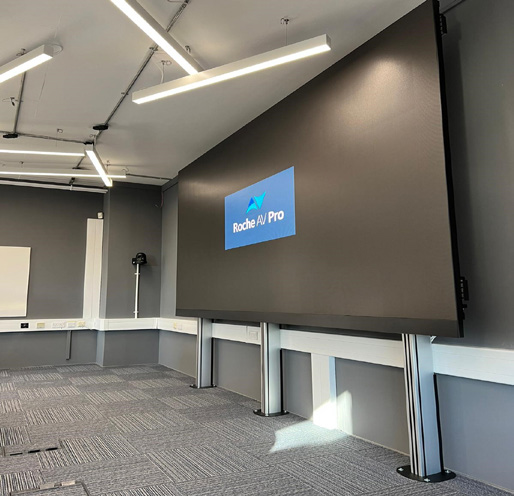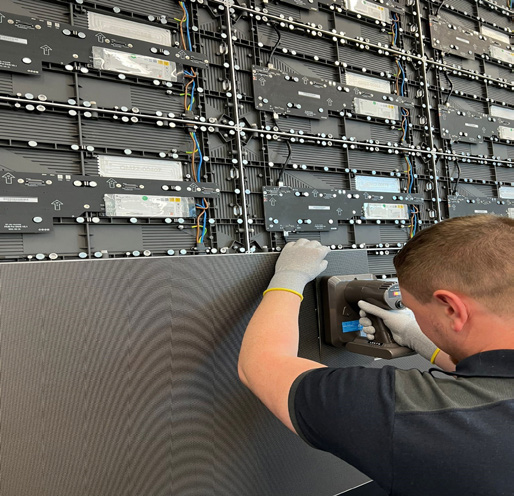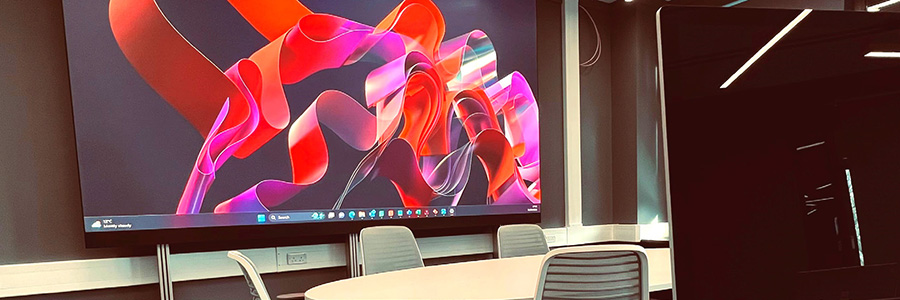Sharp NEC Display Solutions client installation, Higher Education
University of Portsmouth, Space Mission Incubator
Mission-grade performance within budget-limiting parameters
Operating under the tightest of deadlines, orchestrated by Roche AV, Sharp/NEC provides the technology to enable academics and industry experts to visualise space mission design.
Uniting scientists, researchers, and industry experts, the NASA-inspired ‘Space Mission Incubator’ will speed up the development of space missions and give academic-based teams access to the type of heritage and expertise that is crucial to early-stage mission design.
“We want to realise the ambitions of the UK Space Strategy and make the UK a leading space nation, and one of the ways we can do this is by lowering the barrier of access to space, so anybody can access a mission design service,” says Professor Adam Amara, Director of the University’s Institute of Gravitation and Cosmology (ICG).

The service is hosted at a brand-new Concurrent Design Facility (CDF) at the University of Portsmouth, which allows experts from different disciplines to work together on diverse ideas, including space-based solutions to climate change and biodiversity challenges.
The challenge
Creating a Concurrent Design Facility (CDF) was a key objective for the University of Portsmouth - a space capable of adopting the approach pioneered by NASA’s Jet Propulsion Laboratory. The success of this installation means that the University is now one of only a limited number of CDF providers in the UK and Europe.
Key criteria included product availability and affordability as well as fit-for-purpose reliability. Working under extremely tight deadlines with supply issues creating additional pressure, Sharp/NEC and Roche AV were navigating a challenging journey to fulfil the client’s requirements.
“Designing, sourcing and creating a fully functional suite that would be easily usable by up to twenty industry experts, and that facilitates projects worth millions of pounds was no simple feat,” explains Mike Reid, Senior Service Delivery Specialist at the University of Portsmouth.
“Add to that the impossible situation of a five-month time span in a global chip shortage and it becomes a clear testimony to the team at Roche that they have accepted and risen to such a challenge!”
The centrepiece of the facility is a vast 162-inch 1.8mm fine-pitch dvLED surface from Sharp/NEC, expertly integrated by Roche AV. Sharp/NEC has a proven track record at the University as a preferred brand for campus-wide visual systems. Simultaneous to this project for instance, is a summer upgrade program refreshing classrooms with 15 x NEC PA525UL projectors.

The solution
The NEC dvLED E Series satisfies the client’s budget requirements, delivering all the brightness and high contrast advantages of LED technology at low cost. Constructed using a robust aluminium housing, the slim, lightweight design allows the display to be integrated very close to the wall with front-serviceable modules for easy maintenance.
The LED display coupled with a multi-window processor and more traditional video switching delivers endless possibilities for collaboration between multiple users. Any mix of over 40 inputs can be shared both in room and via a UC client creating a unique setting for collaboration both in person and remotely. The FullHD LED display is controlled via a digital canvassing system to allow for multiple modes of presentation. A video conferencing system incorporates two PTZ cameras, a camera for whiteboard documenting and room-encompassing microphones. The system provides a simple and intuitive user experience allowing users to prioritise screens as required, with a control for the room project leader.
Whilst LED technology provides excellent power efficiency, Roche AV’s system designers took extra steps to minimise power usage.
Vacancy sensors within the room will trigger the LEDs to emit no light if motion has not been detected for 30 minutes, as well as during scheduled nighttime hours, saving an estimated 45KhW of electricity every week. In addition, the LED display will shut down entirely during extended periods such as university teaching breaks saving as much as 90KhW each week.
The result
The University of Portsmouth now has a world-class Concurrent Design Facility that can not only help the space industry directly but can also indirectly help inspire and train future engineers.
Despite the complex challenges of this project, final installation started early in April with programming and commissioning completed the following week. From placing the order to completion, the project was successfully achieved within 72 working days, a result which impressed the client.
Reid concluded: “The original vision of having a CDF like NASA’s and adding technologies for full remote presence (using Zoom Rooms) was achieved, it was also enhanced with some visits to technology centres, which helps us to make our decisions quickly. Every aspect of the supply chain was managed excellently and all the technology supply partners including Sharp/NEC, TVOne, Microsoft, Crestron, Barco and Sennheiser elevated their service for us.”
“It is quite possible that an idea worked on in this room, might be realised in a lunar orbiting spacecraft in the near future - we have created the environment in which that can happen.”


